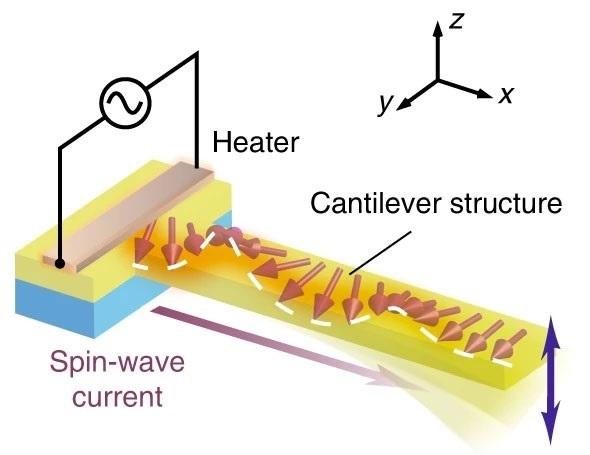A new way to deliver a force to drive micro mechanics

Credit: Kazuya Harii
Micro mechanical elements are indispensable components of modern electrical devices but the actuation of them requires electrical current. It becomes harder to wire the element as further downscaling of device is pursued. As a way out of this issue, researchers demonstrated a new way to deliver a force to drive micro mechanics by spin current.
Spin current is a flow of electron angular momentum in matters. The spin current has been used as a new information carrier in the context of spintronics such as hard disk drives (HDD) head and Magnetic Random-Access Memory (MRAM). In this context, the injection of spin current can control the orientation of micro magnets by exerting magnetic torque.
Considering the angular momentum nature of the spin current, what would happen when the spin current is injected to a mechanical object? The injected excess amount of angular momentum may exert mechanical torque on it. This is the idea.
In this study, the researchers fabricated a micro cantilever structure made of magnetic insulator yttrium iron garnet (YIG: Y3Fe5O12). A metallic thin wire was put on the root of the cantilever as a heater. When electrical current flows in the wire, the wire works as a generator of spin current by spin Seebeck effect and the spin current propagates into the micro cantilever. The researchers measured the vibration of the cantilever while injecting the spin current modulated near the resonant frequency of the micro cantilever. The measurement confirmed that only when the spin current injection of appropriate spin orientation can excite the vibration of the cantilever.
“This driving mechanism of micro machines does not require an electrical wiring on it.” Kazuya Harii, a researcher at ERATO Saitoh Spin Quantum Rectification Project, said. “This mechanism is applicable to any mechanical objects in micro and nano meter scales.”
###
For more information, visit ERATO Saitoh Spin Quantum Rectification Project website.
https:/
Media Contact
Eiji Saitoh
[email protected]
Original Source
http://www.
Related Journal Article
http://dx.




